
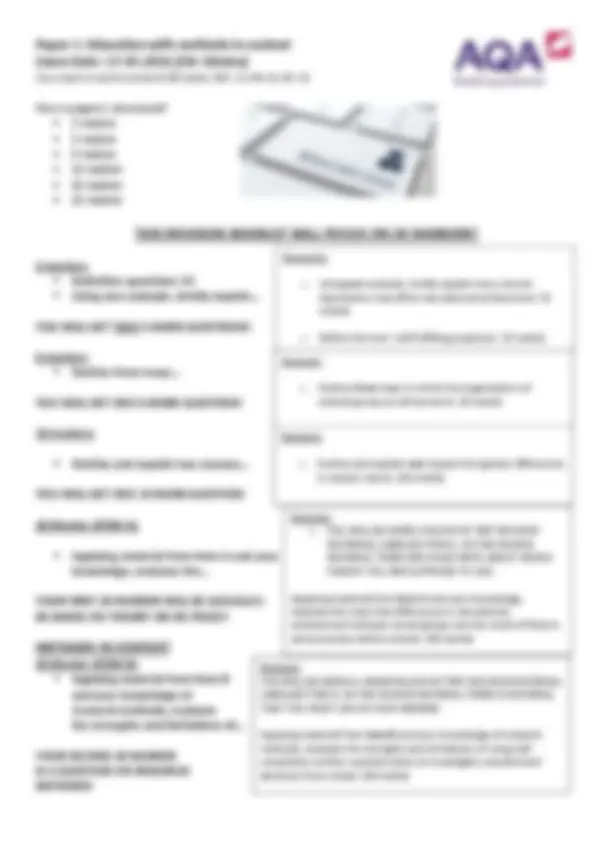
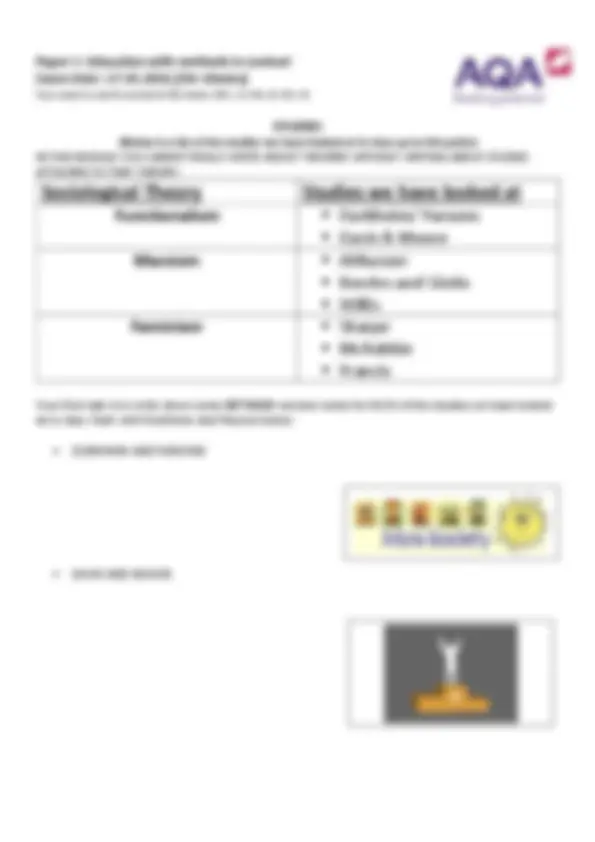
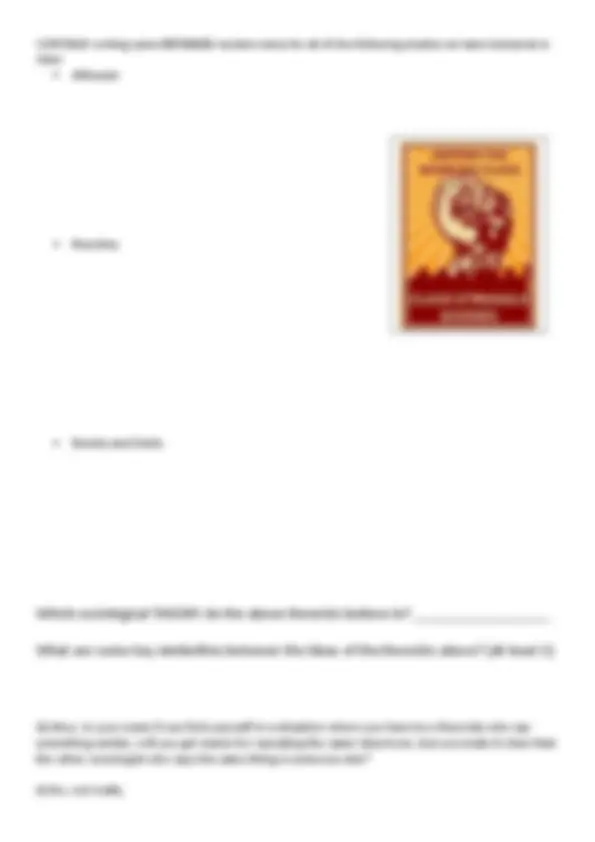
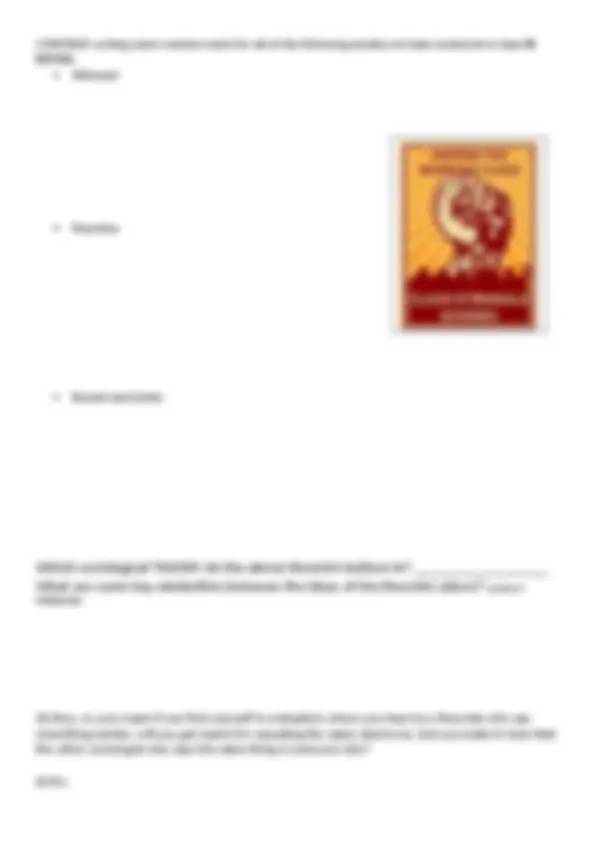
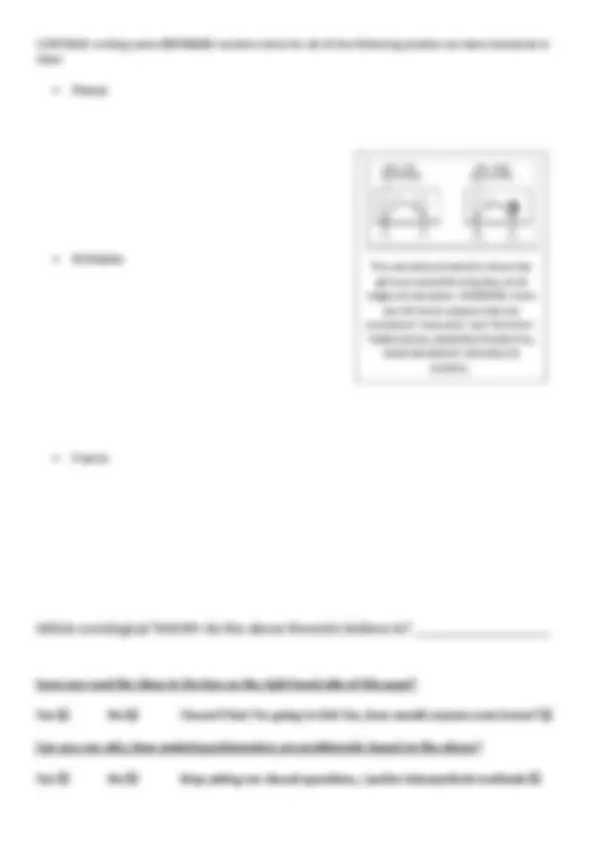
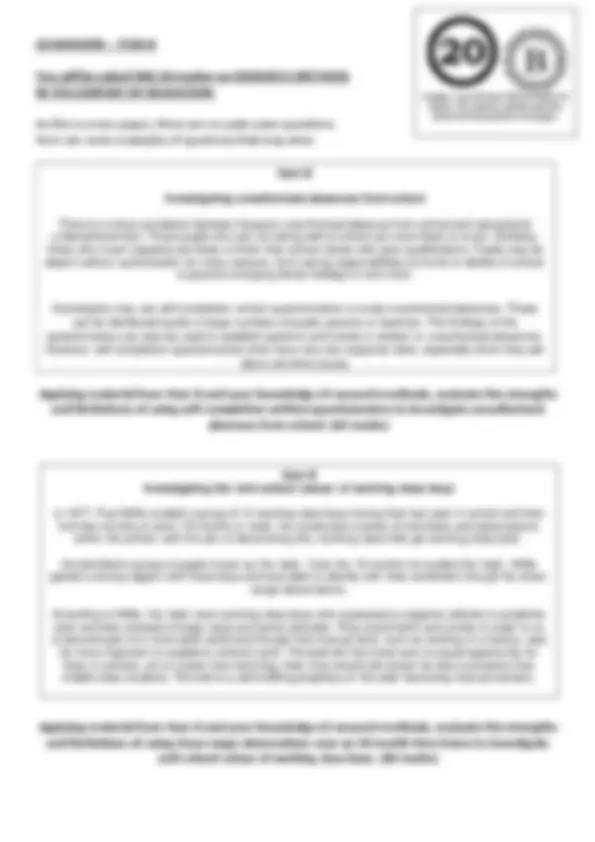
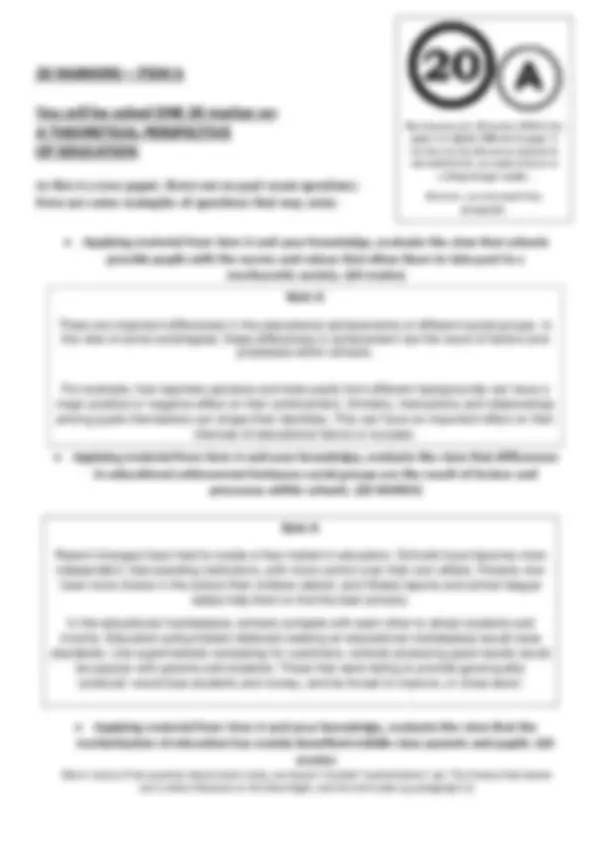
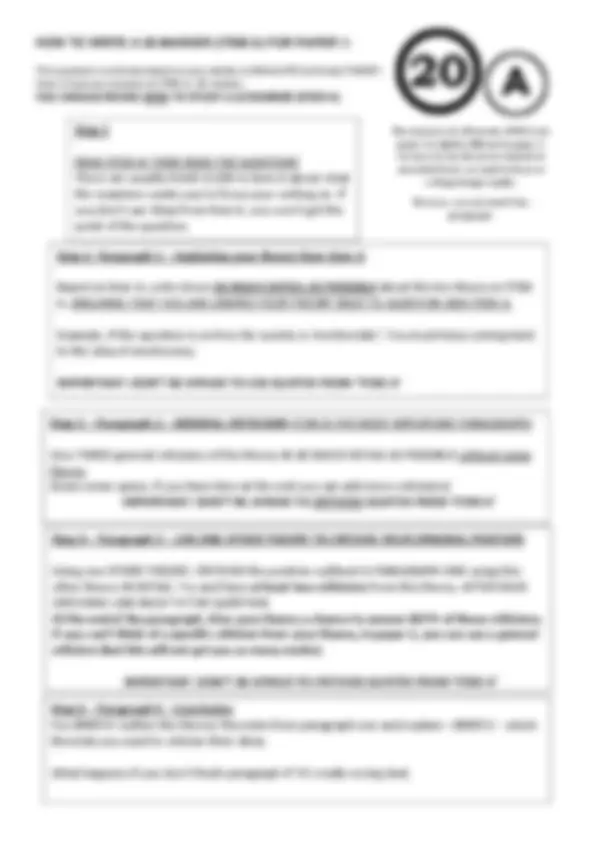
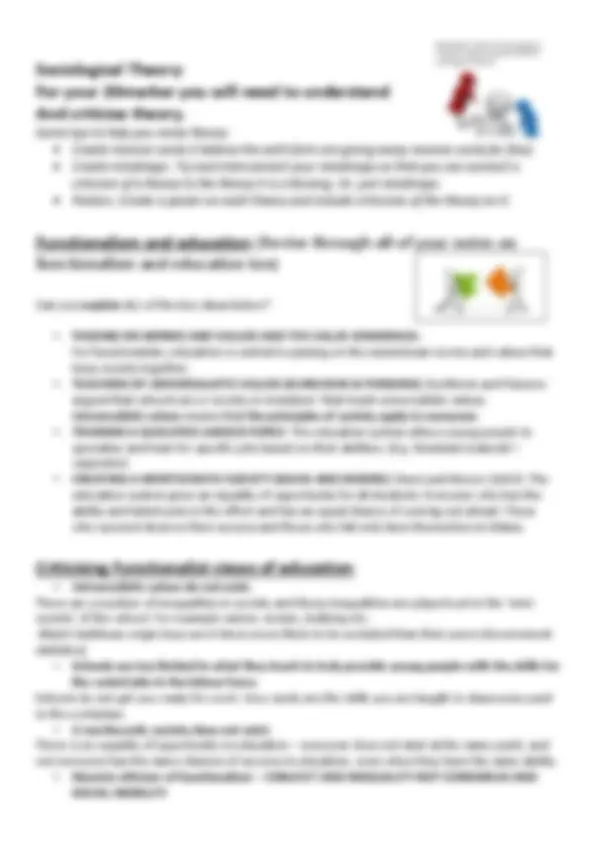
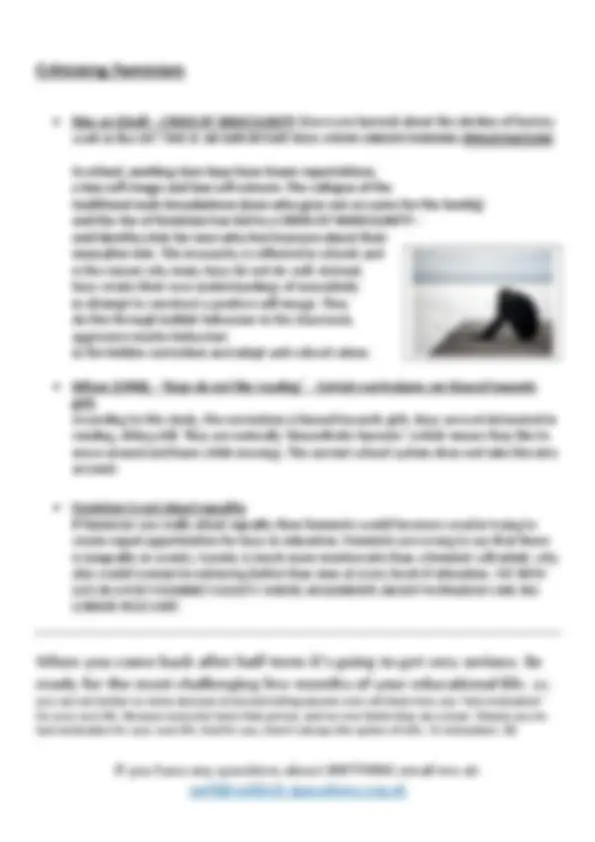


Study with the several resources on Docsity

Earn points by helping other students or get them with a premium plan


Prepare for your exams
Study with the several resources on Docsity

Earn points to download
Earn points by helping other students or get them with a premium plan
Community
Ask the community for help and clear up your study doubts
Discover the best universities in your country according to Docsity users
Free resources
Download our free guides on studying techniques, anxiety management strategies, and thesis advice from Docsity tutors
AS-Level Sociology. Tudor Grange Academy. Education- Revision Booklet 1. This booklet will aid you in your revision for your AS Sociology exam for paper 1.
Typology: Exams
1 / 18

This page cannot be seen from the preview
Don't miss anything!











(One day, this could be you! But it won’t be if you don’t REVISE)
How to use the textbook (again):
Now, just some reminders on how to revise: Use revision cards to memorise studies Create posters/mindmaps COMPLETE EXAM QUESTIONS IN TIMED CONDITIONS
Your exam is worth a total of 60 marks: (54 = A, 48= B, 42= C)
(Below is a list of the studies we have looked at in class up to this point) IN THIS MODULE YOU CANNOT REALLY WRITE ABOUT THEORIES WITHOUT WRITING ABOUT STUDIES ATTACHED TO THAT THEORY! Sociological Theory Studies we have looked at Functionalism Durkheim/ Parsons Davis & Moore Marxism Althusser Bowles and Gintis Willis Feminism Sharpe McRobbie Francis
Your first task is to write down some DETAILED revision notes for EACH of the studies we have looked at in class. Start with Durkheim and Parsons below:
DURKHEIM AND PARSONS
DAVIS AND MOORE
CONTINUE writing some DETAILED revision notes for all of the following studies we have looked at in class: Althusser
Bourdieu
Bowles and Gintis
Q) Now, in your exam if you find yourself in a situation where you have two theorists who say something similar, will you get marks for repeating the same idea twice, but you make it clear that the other sociologist who says the same thing is someone else?
A) No, not really.
Hopefully that was fun and you enjoyed it more than anything you’ve ever done before. Let’s say, just for argument’s sake you didn’t enjoy it…No‐one cares. Maybe you’ll enjoy it more the second time around:
Your task is to write down some revision notes for EACH of the studies we have looked at in class. Start with Durkheim and Parsons below:
DURKHEIM AND PARSONS
DAVIS AND MOORE
CONTINUE writing some revision notes for all of the following studies we have looked at in class IN DETAIL: Althusser
Bourdieu
Bowles and Gintis
Q) Now, in your exam if you find yourself in a situation where you have two theorists who say something similar, will you get marks for repeating the same idea twice, but you make it clear that the other sociologist who says the same thing is someone else?
A) No.
You will be asked ONE 20 marker on RESEARCH METHODS IN THE CONTEXT OF EDUCATION:
As this is a new paper, there are no past exam questions. Here are some examples of questions that may arise:
Applying material from Item B and your knowledge of research methods, evaluate the strengths and limitations of using self‐completion written questionnaires to investigate unauthorised absences from school. (20 marks)
Applying material from Item B and your knowledge of research methods, evaluate the strengths and limitations of using close‐range observations over an 18 month time frame to investigate anti‐school values of working class boys. (20 marks)
Item B Investigating unauthorised absences from school underachievement. Those pupils who are not doing well at school are more likely to truant. Similarly,^ There is a close correlation between frequent unauthorised absence from school and educational absent without authorisation for many reasons, from caring responsibilities at home or dislike of school,those who truant regularly are likely to finish their school career with poor qualifications. Pupils may be to parents arranging family holidays in term time. Sociologists may use self-completion written questionnaires to study unauthorised absences. These can be distributed easily to large numbers of pupils, parents or teachers. The findings of the However, self-completion questionnaires often have very low response rates, especially when they askquestionnaires can also be used to establish patterns and trends in relation to unauthorised absences. about sensitive issues
Investigating the ‘anti-school values’ of working class boys^ Item B In 1977, Paul Willis studied a group of 12 working-class boys during their last year in school and theirfirst few months at work (18 months in total). He conducted a series of interviews and observations within the school, with the aim of discovering why 'working class kids get working class jobs'. gained a strong rapport with these boys and was able to identify with their worldview through his close-He identified a group of pupils known as the ‘lads’. Over the 18 months he studied the ‘lads’, Willis range observations. According to Willis, the ‘lads’ were working class boys who expressed a negative attitude to academicwork and also showed strongly racist and sexist attitudes. They would drink and smoke in order to try to become part of a more adult world and thought that manual work, such as working in a factory, wasfar more important to academic (school) work. The lads felt that there was no equal opportunity for middle class students. This led to a self-fulfilling prophecy of ‘the lads’ becoming manual workers.them in schools, as no matter how hard they tried, they would still remain far less successful than
In (^) answer.paper (^1) Theyou researchwill have methodsTWO 20 markersquestion to will be the final question in the paper.
20 MARKER – ITEM B RESEARCH METHOS IN CONTEXT
How to answer a 20 marker (ITEM B) question (3 paragraphs in total)
ITEM B will contain a lot of information. This information may be to do with PET issues, or it may be to do with a specific advantage or disadvantage of the main research method being asked about.
P ractical = T ime, A ccess, F unding (problems) E thical = ‐ Informed consent ‐ Anonymity ‐ Is all research unethical? T heoretical= Which theorist would want To use this method? Why? EVERY SINGLE SENTENCE YOU WRITE ABOUT MUST LINK BACK TO THE CONTEXT PRESENTED IN ITEM B AND THE QUESTION. IF YOU DO NOT DO THIS YOU CANNOT GET ABOVE AN ‘E’ GRADE. Use key words! (use keywords that are relevant only) IS THIS A POSITIVIST/INTERPRETIVIST METHOD? WHY WOULD THE OPPOSING THEORISTS CRITICISE THIS? VALIDITY/RELIABILITY QUAL/QUANT GENERALISABILITY/REPRESENTATIVENESS RAPPORT/ HAWTHORNE VERSTEHEN/BIAS SAMPLE/ SAMPLING FRAME PRIMARY/ SECONDARY EVERY SINGLE SENTENCE YOU WRITE ABOUT MUST LINK BACK TO THE CONTEXT PRESENTED IN ITEM B AND THE QUESTION. IF YOU DO NOT DO THIS YOU CANNOT GET ABOVE AN ‘E’ GRADE. Use key words! (use keywords that are relevant only) IS THIS A POSITIVIST/INTERPRETIVIST METHOD? WHY WOULD THEY ARGUE IT’S A GOOD METHOD? VALIDITY/RELIABILITY QUAL/QUANT GENERALISABILITY/REPRESENTATIVENESS RAPPORT/ HAWTHORNE VERSTEHEN/BIAS SAMPLE/ SAMPLING FRAME PRIMARY/ SECONDARY
EVERY SINGLE SENTENCE YOU WRITE ABOUT MUST LINK BACK TO THE CONTEXT PRESENTED IN ITEM B AND THE QUESTION. IF YOU DO NOT DO THIS YOU CANNOT GET ABOVE AN ‘E’ GRADE.
In (^) answer.paper (^1) Theyou researchwill have methods TWO 20 markersquestion to STEP 1 will^ be^ the^ final^ question^ in^ the^ paper. READ ITEM B & THE QUESTION CAREFULLY and be clear which research method is being asked about. There are huge clues in Item B to help you.
(Don’t worry if the out question is either above Marxism looks or scary, the New we haven’tRight, and studied this will ‘marketisation’ make up paragraph yet. The 1.) theory that stands
The paper structure 1 is slightly of a (^20) different marker to(ITEM paper A) 2.for You more have detail to and,use the you source need tomaterial focus on in writing stronger replies. However, paragraphs. you only need 3 key
Item A There are important differences in the educational achievements of different social groups. In the view of some sociologists, these differences in achievement are the result of factors andprocesses within schools.
For example, how teachers perceive and treat pupils from different backgrounds can have a major positive or negative effect on their achievement. Similarly, interactions and relationships among pupils themselves can shape their identities. This can have an important effect on their chances of educational failure or success.
Item A Recent changes have tried to create a free-market in education. Schools have become more independent, free-standing institutions, with more control over their own affairs. Parents now have more choice in the school their children attend, and Ofsted reports and school league tables help them to find the best schools. In the educational marketplace, schools compete with each other to attract students and income. Education policymakers believed creating an educational marketplace would raise standards. Like supermarkets competing for customers, schools producing good results would be popular with parents and students. Those that were failing to provide good-quality ‘products’ would lose students and money, and be forced to improve, or close down.
HOW TO WRITE A 20 MARKER (ITEM A) FOR PAPER 1: This Here question is how you is entirely answer basedan ITEM on A, your 20 abilitymarker: to EVALUATE (criticise) THEORY. YOU SHOULD REVISE HOW TO STUDY A 20 MARKER (ITEM A)
Step 1 READ ITEM A! THEN READ THE QUESTION! There are usually HUGE CLUES in item A about what the examiner wants you to focus your writing on. If you don’t use ideas from Item A, you won’t get the point of the question. Step 2 ‐ Paragraph 1 – Explaining your theory from Item A Based on Item A, write down AS MUCH DETAIL AS POSSIBLE about the key theory in ITEM A, ENSURING THAT YOU ARE LINKING YOUR THEORY BACK TO QUESTION AND ITEM A. Example, if the question is on how far society is ‘meritocratic’. You must keep coming back to the idea of meritocracy. IMPORTANT: DON’T BE AFRAID TO USE QUOTES FROM ‘ITEM A’ Step 3 – Paragraph 2 – GENERAL CRITICISMS (THIS IS THE MOST IMPORTANT PARAGRAPH) Give THREE general criticisms of the theory IN AS MUCH DETAIL AS POSSIBLE without using theory. (leave some space, if you have time at the end you can add more criticisms) IMPORTANT: DON’T BE AFRAID TO CRITICISE QUOTES FROM ‘ITEM A’ Step 4 – Paragraph 3 – USE ONE OTHER THEORY TO CRITICSE YOUR ORIGINAL POSITION Using one OTHER THEORY, CRITICISE the position outlined in PARAGRAPH ONE using this other theory IN DETAIL. Try and have at least two criticisms from this theory. AFTER EACH CRITICISM: LINK BACK TO THE QUESTION. At the end of the paragraph. Give your theory a chance to answer BOTH of these^ criticisms. IF you can’t think of a specific criticism from your theory, in paper 1, you can use a general criticism (but this will not get you as many marks). IMPORTANT: DON’T BE AFRAID TO CRITICISE QUOTES FROM ‘ITEM A’ Step 6 – Paragraph 4 – Conclusion You BRIEFLY outline the theory/ theorists from paragraph one and explain – BRIEFLY ‐ which theorists you used to criticise their ideas. What happens if you don’t finish paragraph 4? It’s really no big deal.
The paper structure 1 is slightly of a (^20) different marker to(ITEM paper A) 2.for You more have detail to and,use the you source need tomaterial focus on in writing stronger replies. However, paragraphs. you only need 3 key
Marxism and education (use your notes and textbook too!)
Criticising Marxist views of education
Feminist views of education (Read through your notes on feminism/ textbook for more detail)
Feminism
McRobbie to know is afor theorist both papers you need